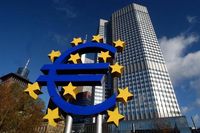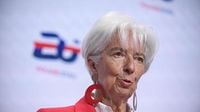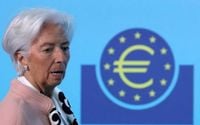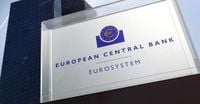The European Central Bank (ECB) has taken another significant step in its monetary policy by reducing interest rates on April 17, 2025. The deposit rate, which serves as the benchmark, has been cut from 2.50% to 2.25%, marking the seventh reduction since June 2024. This latest cut follows a series of adjustments aimed at responding to ongoing economic uncertainties and trade tensions.
In addition to the deposit rate, the ECB has also lowered the rate on main refinancing operations from 2.65% to 2.40% and the rate on marginal lending facilities from 2.90% to 2.65%. This decision was made during a meeting of the ECB's Governing Council and reflects a broader strategy to mitigate the impact of global economic challenges.
ECB President Christine Lagarde emphasized the need for caution in her remarks following the announcement. She stated, "The economic prospects are clouded by exceptional uncertainties," referring to the disruptions in international trade and geopolitical tensions that continue to weigh heavily on consumer confidence and investment. Lagarde's comments underscore the delicate balance the ECB must maintain as it navigates these turbulent economic waters.
During discussions leading up to the decision, some council members even raised the possibility of a more substantial cut of 50 basis points, but this idea was ultimately set aside. Instead, the council opted for a more measured approach, reflecting the complexities of the current economic landscape.
Despite the challenges, the ECB remains optimistic about the disinflation process, which it believes is well underway. The bank expects inflation to stabilize around its medium-term target of 2%. Lagarde noted, "The disinflation process is well underway," and highlighted that both overall and core inflation have decreased as of March 2025.
The decision to cut rates is not merely a reaction to current conditions but also a proactive measure to support the Eurozone economy, which has shown some resilience to global shocks. However, the ECB acknowledges that the prospects for expansion have deteriorated due to rising trade tensions. Lagarde stated, "The greater uncertainty is likely to reduce confidence among households and businesses, and the adverse and volatile market response to trade tensions is likely to tighten financing conditions further."
The ECB's latest statement also reflects a shift in its assessment of the economy. The focus has moved towards the elevated growth of wages, which is partly being absorbed by moderating profits. This nuanced understanding indicates that the ECB is adapting its strategies to the evolving economic realities.
Market analysts have been closely monitoring the ECB's moves, with many predicting further rate cuts in the coming months. Dean Turner, Chief Eurozone Economist at UBS Global Wealth Management, anticipates another cut in June, with potential for additional easing later in the year, depending on the outcomes of ongoing trade negotiations.
Moreover, Goldman Sachs Asset Management forecasts three more consecutive rate cuts in upcoming meetings, potentially bringing the deposit rate down to 1.5% by the end of the year. This perspective aligns with the broader sentiment that the ECB will maintain a flexible and data-driven approach, making decisions on a meeting-by-meeting basis.
As the ECB continues to navigate these uncertain waters, the implications of its decisions extend beyond just interest rates. The recent cuts are expected to impact households significantly, particularly in terms of mortgage rates. Analysts have indicated that the new rate cut will favor reductions in interest rates applied to mortgages by banks to families. The average fixed mortgage rate could soon hover around 2.55%, a notable decrease from the 4% seen just a year ago.
For families, this means potential savings on monthly mortgage payments. For instance, savings on a 10-year loan could range between 37 and 182 euros, while those with 30-year mortgages could see reductions exceeding 200 euros per month. Such changes could provide much-needed relief to households facing rising costs.
However, the ECB remains vigilant about the potential impacts of external factors, particularly the ongoing trade war initiated by the United States. Lagarde pointed out that the response to U.S. tariffs could have varying effects on inflation, with the uncertainty surrounding these trade policies likely to complicate the economic outlook further.
In her closing remarks, Lagarde reiterated the importance of fiscal and structural policies in enhancing the productivity and resilience of the Eurozone economy. She emphasized that it is crucial for European institutions to collaborate on initiatives that will bolster economic growth, competitiveness, and stability.
As the ECB prepares for its next meetings, the focus will remain on closely monitoring inflation dynamics and the broader economic landscape. The bank's commitment to a data-driven approach will guide its decisions as it seeks to navigate the complexities of the current global economic environment.
In summary, the ECB's latest interest rate cut reflects a strategic response to ongoing economic challenges, with an emphasis on supporting growth while managing inflation. As uncertainties persist, the central bank's actions will be critical in shaping the Eurozone's economic trajectory in the months ahead.









